Subaru, more than just about any other brand, is inextricably associated with the outdoor lifestyle. You see Subies adorned with kayaks and bike racks, spattered with mud, far more often than any hardcore SUV. But while a Jeep makes off-roading its own occasion, a Subaru is meant to take you to your outdoor fun — be it a campsite, hiking trail, or singletrack through the woods.
But with an estimated 228 miles of battery range, will the all-electric Subaru Solterra get you there and back? Are you willing to spend $45,000 to find out?
Full Disclosure: Subaru brought me out to California to test the Solterra on the roads around Santa Barbara and the trails of Catalina Island. The automaker paid for my airfare, food, and lodging, including a single-prop airplane ride to and from Catalina. Turns out, single-prop airplanes rule.
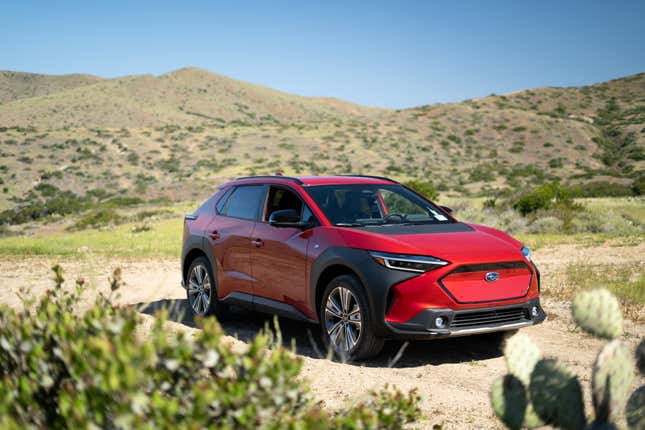
What Is the Subaru Solterra?
The Solterra is Subaru’s first full EV. The company dipped its toes into electrification with the Crosstrek Hybrid, but the Solterra is the first U.S.-market Subaru without a boxer engine since the Justy left the scene. Whether it wants to be or not, this new vehicle is the future of Subaru — what the six-star badge will come to mean in the age of EVs.
On a more practical note, though, the Solterra is just a standard five-seat crossover. It’s a bit longer, a bit wider, and a bit lower than a Forester, with a wheelbase closer to that of the Ascent. Subaru claims this makes for stable highway cruising while providing generous approach and departure angles for off-roading, but it also makes for the lowest ground clearance of any Subie crossover.
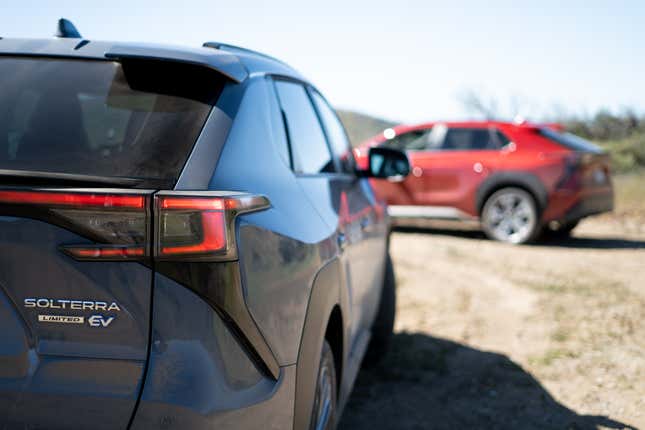
The Solterra is targeted at weekend warriors, so much so that Subaru’s media presentation actually included an image of the crossover parked outside an REI. It’s built to carry a rooftop tent, so long as the whole assembly (including occupants) doesn’t exceed 700 pounds, and the rear bumper is unpainted raw plastic so your dog doesn’t scratch it up climbing in. Whether the black plastic can resist daily scrapes from dog claws remains to be seen, but at least you won’t have to pay for color-matched paint.
The Solterra has Subaru’s most divisive styling since the new WRX, and also every previous WRX. The plastic fender flares make some sense in an off-roadish vehicle, and the way they extend up to the headlights makes the car stand out from the crowd. It looks fine — good, even — when you see it in person. Better than the bZ4X, if I had to pick.
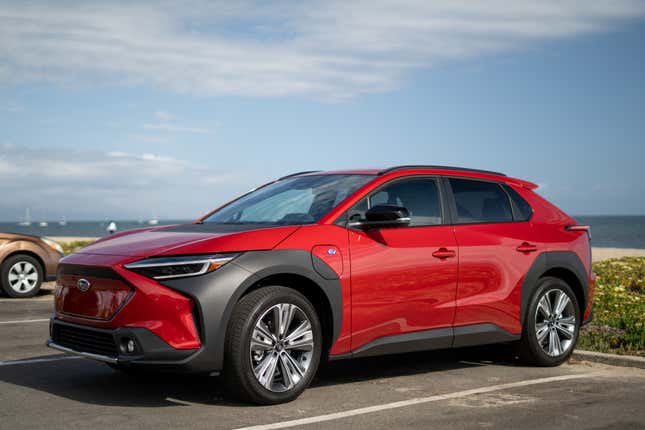
How Is the Solterra Off-Road?
Subaru wants the Solterra to ferry its owners to parts unknown. To show off its off-road prowess, the company shipped a few Solterrae to California’s Catalina Island for journalists to audit in a light off-road setting. The route had tight dusty trails, harsh inclines and descents, and rutted, broken surfaces, all to be traversed with stock all-season tires.
I’ll admit, I’m no master ‘froader. My experience is limited to fire roads, desert trails, and the occasional grass parking spot. For a beginner, the Solterra’s electric drivetrain makes casual dirt-roading easy — though not for the reasons you may think.
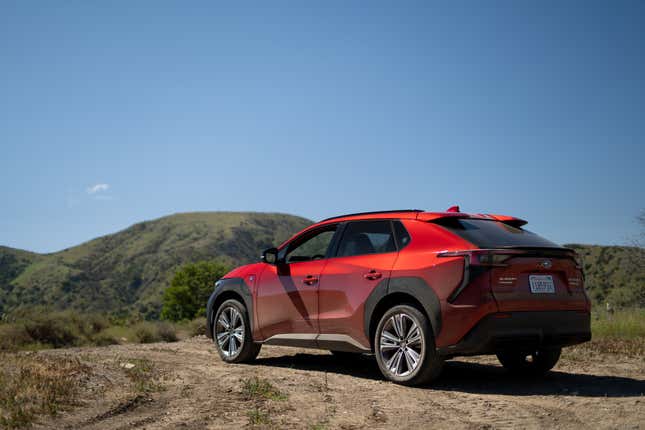
I don’t doubt that instant EV torque is a massive benefit when tackling rough terrain. Look no further than the trail-ready Rivian R1T and its famous Hells Gate climb for proof of that. But I do doubt that we overworked the Solterra’s 249 lb-ft torque puttering around Catalina Island. After all, our chase vehicle was an Outback, and not even the rough-and-ready Wilderness we’ve tested — clearly, a boxer and a CVT will get you to the same places.
What the electric motors did do is make things easy. I never had to work to keep an engine in its powerband; none of my jet-lagged mental capacity went towards working with (or against) a CVT to find the right gear ratio. The Solterra allowed me to pick a line, ease into the power, and focus on keeping the car steady without breaking traction. Training wheels for off-roading.

How Is the Solterra On-Road?
A weekend warrior still needs to survive the week. For most prospective Solterra owners, that probably means a daily commute to a well-paying office job, maybe with a stop on the way for a cup of granola and an oat milk latte. As a person with an office job and a weakness for granola and oat milk lattes, the Solterra should have been a perfect fit for me. So why didn’t it live up?
As a plain commuter, the Solterra is... fine. The ride is soft, smooth, and quiet, and the handling and steering as competent and unassuming as you’d expect from a vehicle in this class. The car has four separate settings for regenerative braking; I found myself wishing I could set it to three and a half. Like its Toyota cousin, the bZ4x, the Solterra won’t come to a full stop through regenerative braking alone (at least, in any reasonable distance). The floor full of batteries makes for a low center of gravity, which helps the Solterra handle corners better than a Forester.
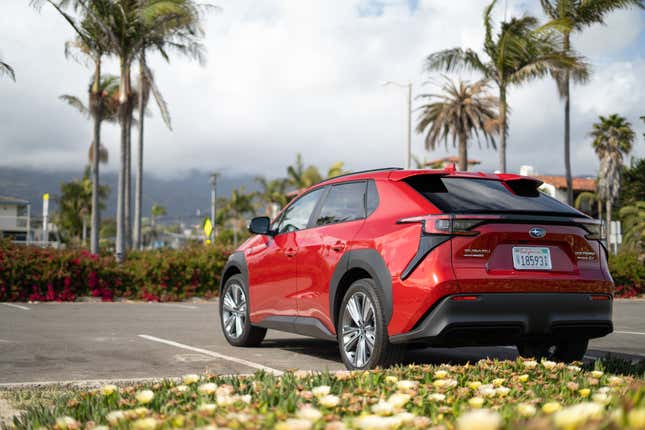
With such a staid driving experience, your attention wanders to the interior — and its shortcomings. The Solterra’s interior feels every bit like a Toyota/Subaru collaboration. Subaru’s signature hard, matte plastic is here, newly paired with Toyota’s gloss black accents. The infotainment is Toyota in its placement but Subaru in its functionality — both good and bad.
Subaru’s infotainment is generally pretty modern, sleek and fast enough to not be objectionable. But Subaru is also a bit weird, and the company’s odd habits create some nitpicks on that more-than-a-foot-wide center screen. Settings are often buried under seemingly irrelevant menus and submenus, and the car’s “Cloud Navigation” is inoperable without cell signal — a tough pill to swallow in a vehicle meant to take you off the grid.
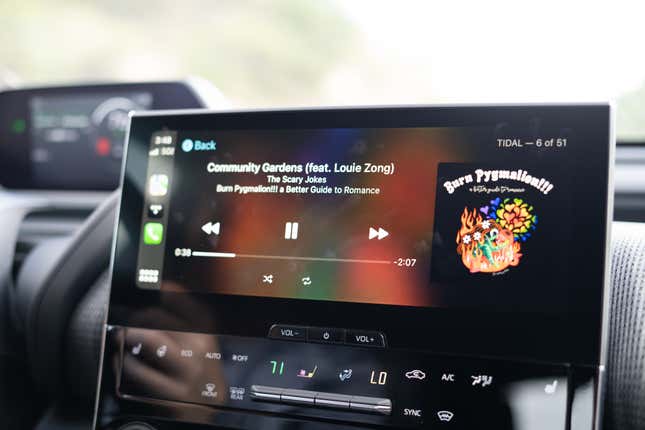
Then, there’s the home button, or lack thereof. Once you enter CarPlay or Android Auto, there’s no natural way to exit. At the media drive, Subaru’s representatives spent lots of time talking about how they worked to make the car easy to operate with gloves on, and yet, there’s no physical home button on the infotainment screen, and no permanent placement of such a button on the screen itself. Instead, you have to locate the Subaru button in the app list — a struggle if your phone has lots of apps compatible with CarPlay/Android Auto.
Then there’s the gauge cluster. Depending on your seating position, the top of the steering wheel may cut the instrument panel neatly in half, with the bottom unreadable. While that lower half is mainly empty on the left and a mess of icons on the right, it’s still got some valuable information — which you, the driver, cannot see. While sitting in the (parked) car, I put my camera directly at eye level to document my view of the gauges. It wasn’t great.
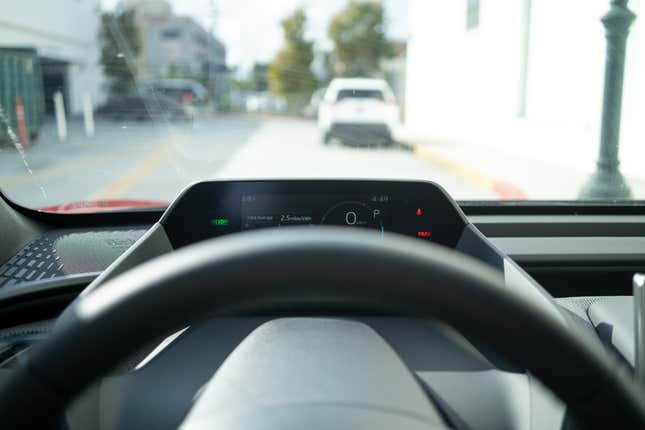
How Does the Solterra Compare to the Competition?
Much the same as the bZ4X, with just a few tweaks. The Solterra’s base price of $44,995 (before destination charge and EV tax incentives) is roughly $3,000 higher than the Toyota, in part because the Subie comes standard with all-wheel drive. Subaru does have the advantage of tax credits—Toyota has sold enough plug-in hybrids in the U.S. to have maxed out the federal rebate. For now that makes the Subaru effectively cheaper than the Toyota after federal rebates, but that’s not a long-term solution, especially when you consider how many similarly-sized, internal combustion-powered crossovers price well below $40,000.
Subaru says its customers are “willing to make sacrifices to own a vehicle that doesn’t pollute the environment,” citing its own market research studies. But the sacrifices here are considerable — a maximum of 228 miles of range, with arguably less off-road capability than a base Forester.

Specs To Know
- Starting MSRP: $44,995
- Range: 222 mi (Limited and Touring models), 228 mi (Premium)
- AWD standard
- 215 hp
- 249 lb-ft torque
- 72.8 kWh battery
- 80% charge in 56 minutes on DC fast charging, full charge in 9 hours from Level 2
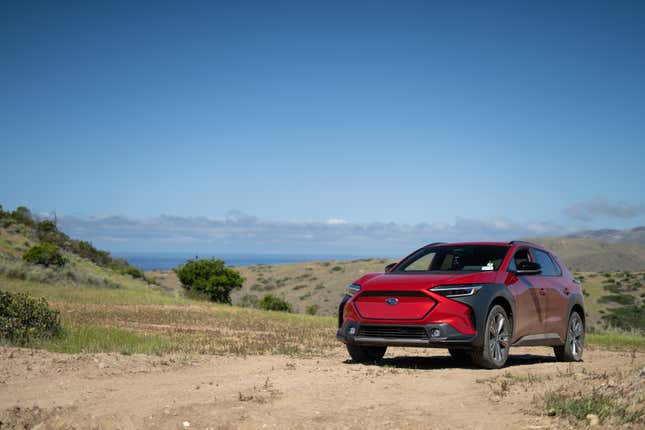
The Verdict
Before arriving to the Solterra drive event, I had one big question: Is this thing weird enough to be a Subaru? The answer is a resounding yes. But in California, a new question sprung to mind: Is the Solterra a Subaru for EV buyers, or an EV for Subaru buyers?
The answer to that one is tricker. The Solterra’s base price is high, and “Symmetrical” all-wheel drive isn’t much of a standout feature when so many EVs have dual motors anyway. There’s little to make the Subaru stand out from other EVs on the market, and little to entice you to choose it over, say, a Mustang Mach-E.
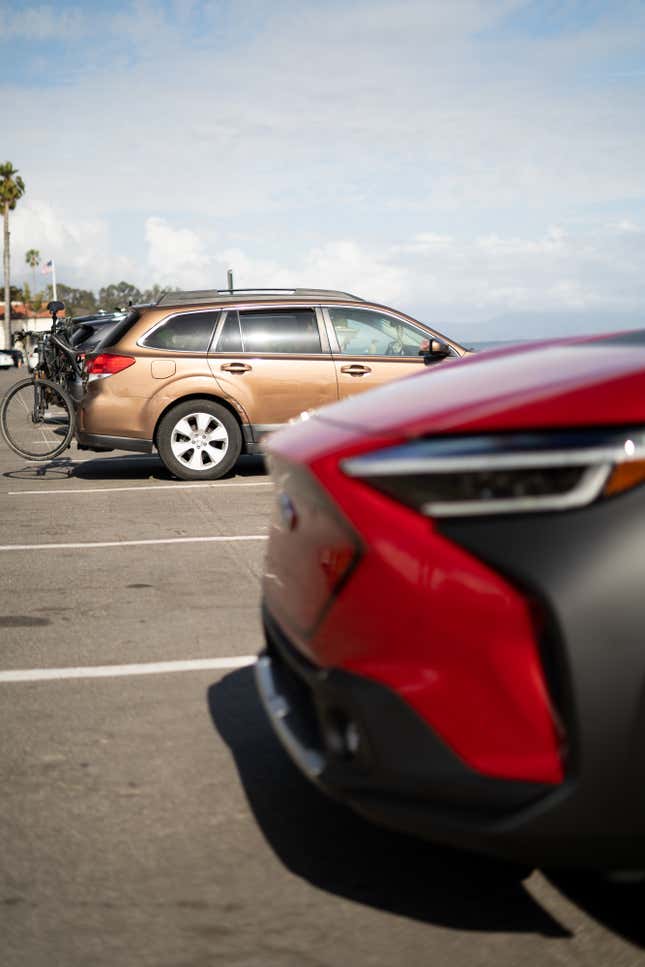
The Solterra, then, is an EV for the Subaru faithful. Given that Subaru has already sold basically all its Solterras for 2022, the faithful appear to have eaten it up. But the Solterra doesn’t appear to do anything a Forester can’t, and it asks a $20,000 premium for the singular selling point of “being electric.” That’s a trade some people are clearly willing to make right now, in the first year of production. But how long will that last?
Subaru wants Solterra owners to visit the great outdoors, but will range anxiety dissuade them? Subaru owners seem to keep their cars forever, but will that hold true when EV batteries degrade? The Solterra is a perfectly fine adventure vehicle for the weekend warrior, but in such a crowded market, it’s unclear how it will fare in the weekend wars.